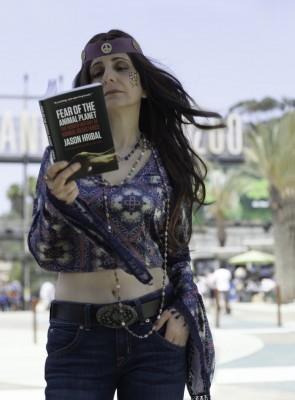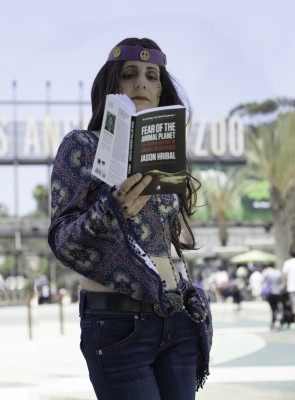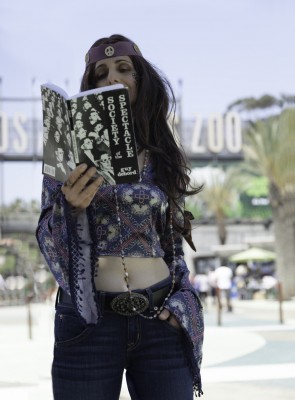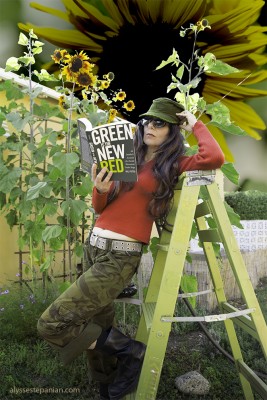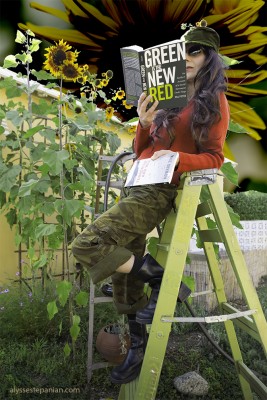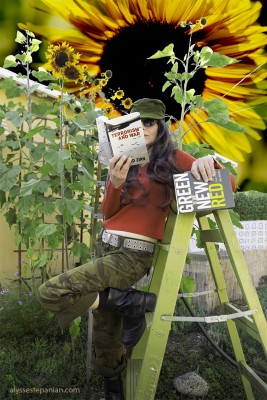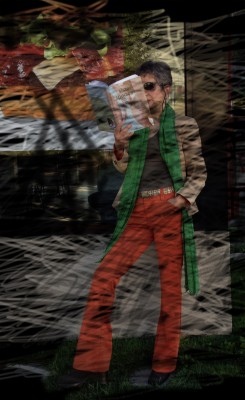Interconnected Oppressions is a series of animated GIFs and photographs. For each piece I am photographed with paired books in a related setting, to reveal intersections of injustices for human and nonhuman animals. I think that all injustices are interconnected: looking away from one weakens the arguments made against another.
Monopoly of Appearance

click on image above to view animation.
Scroll down to read about this work & view the individual photographs.
3rd in the Interconnected Oppressions series
April – May 2015
Animated GIF and series of 4 photographs
Sunflowers Instead of Missiles
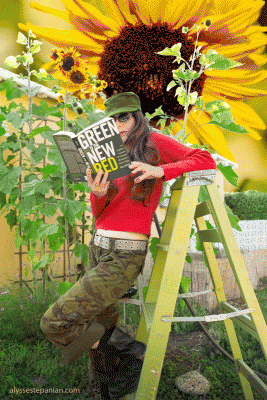
click on image above to view animation.
Scroll down to read about this work & view the individual photographs.
2nd in the Interconnected Oppressions series
April – May 2015
Animated GIF and series of 7 photographs
The Meat that Therefore I Am

click on image above to view animation.
Scroll down to read about this work & view the individual photographs.
1st in the Interconnected Oppressions series
December 6, 2014
Animated GIF and series of 6 photographs
ABOUT
Monopoly of Appearance
Photography: in collaboration with Philip Mantione.
Click on images to enlarge.
The two books featured here are “Society of the Spectacle” (1967) by Guy Debord, and Jason Hribal’s “Fear of the Animal Planet: The Hidden History of Animal Resistance” (2010). In “Society of the Spectacle” Debord discusses the “monopoly of appearance” in a passive society that is controlled by images of mass media and popular culture to such extent that reality and fiction are confused. Using the backdrop of a zoo, I bring to the attention of the viewer that zoo animals live under the tyranny of the most extreme form of this spectacle. The language used to refer to the lives of these animals in the zoo literature and website is the language of control and museumification of nature and it’s not surprising that the Los Angeles Zoo is even accredited by the American Association of Museums. The zoo “curators” pride themselves of their “acquisitions” of “charming creatures” for their “state-of-the-art exhibitions” that “showcase” “beautifully themed” habitats with “hand-painted murals” that exemplify their natural environments. Quoting Debord, “the tangible world is replaced by a selection of images which exist above it” (36).
Jason Hribal’s “Fear of the Animal Planet” tells true stories of deception and exploitation of animals used for entertainment, in zoos and for other human purposes. He reveals the intelligence and individuality of each animal and tells their life stories from the time they were kidnapped by profit seeking humans, to the time of rebellion and ingeniously planned escape or fight for freedom and death. We learn about the cover up by institutions that hold these animals captive and their monopoly of appearance for audiences that want to believe that these animals are willing participants in a destiny designed to benefit them.
In these images I am depicted as a hippie, reading the above-mentioned books with the zoo entry banner looming in the background. Some of the 1960’s subculture ideologies were harmony with nature, anti-war and anti-materialism, and individuality and compassion. Many of the hippies were active in the Civil Rights movement of the 1960’s. It might be a combination of the new consciousness of that era, along with the need for larger and more impressive “exhibitions” that led to the closure of the old zoo in 1966.
While Debord was writing during the era of the Civil Rights Movement in Paris, about the capitalist system’s oppression of humans, his words seem resoundingly true for the condition of the animals kept in bondage by humans: “the spectacle is nothing more than an image of happy unification surrounded by desolation and fear at the tranquil center of misery” (Debord, 63).
ABOUT
Sunflowers Instead of Missiles
“Sunflowers Instead of Missiles” is the second of the animated GIFs and photographs in the “Interconnected Oppressions” series. For each piece the artist is photographed with paired books in a related setting. The two books presented here are “Green is the New Red” by Will Potter, and “Terrorism and War” by Howard Zinn. These authors’ discussions run parallel regarding the government’s routine labeling of social, political, “animal” rights and environmental activists as “terrorists” in campaigns of intimidation designed to stifle voices of dissent.
The number of women in the “animal” rights movement exceeds that of men, perhaps due to their own history of repression under patriarchal rule. The artist in this image exudes a combination of female self-awareness as an intellectual, sexual, nurturing, forceful, independent and dynamic being. Her pacifism is ironically camouflaged under military garb, a reflection of the falsified representation and intentional vilification of protesters and activists.
The sunflower motif, a plant native to the Americas, is dominant in this work. One of the fastest growing plants, tall and erect sun-like sunflowers reach for and face the sun, and are said to symbolize nonconformity, strength, vitality, loyalty, love, beauty, happiness and enlightenment. Sunflowers are also a source of food and sustenance. Their color yellow is associated with the intellect, perception and self-awareness, and orange is linked with creativity, expansion, self-acceptance and confidence.
Sunflowers are symbolically referenced for their reliance on clean solar energy. Inspired by the phytoremediation project following the 1986 Chernobyl nuclear crisis, the Fukushima Sunflower Foster Parent Project was designed to clean up the toxicity of the soil via the plant’s alleged capacity to absorb radiation. In 1998 activists known as the Missouri Peace Planters simultaneously planted sunflowers in 10 nuclear missile silos.
In 1996 sunflower seeds were planted at a former nuclear missile base, to symbolize Ukraine’s commitment to become free of nuclear weapons. “Sunflowers instead of missiles” were the words uttered by the U.S. Secretary of Defense at that ceremony. Ironically, by 1996 the U.S. government had spent trillions on nuclear weapons, and the U.S. was the first country to manufacture and the only country to have used nuclear weapons in war.
*Special thanks to my dear friend Marcela Esparza for her invaluable help with the photo shoot.
ABOUT
The Meat that Therefore I Am
This is the first of the animated GIFs and photographs in the “Interconnected Oppressions” series. The two books presented in this work are “The Sexual Politics of Meat” by Carol J. Adams and “Sister Species: Women, Animals, and Social Justice” edited by Lisa Kemmerer. The backdrop is a fast food restaurant window poster of a hamburger. This particular restaurant has been using the female body in its TV commercials for selling its burgers – woman’s body represented and desired just as a piece of “meat”.
*This work was first created for the Hidden Art Exhibit curated by Tamara De Laval based in Sweden. Special thanks to Tamara for the still photos.
